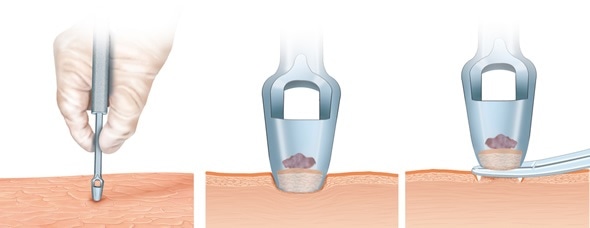A punch biopsy is a medical procedure that acquires tissue for laboratory examination, usually through tissue culture or microscopy, by taking a punch-size piece of skin from the body. It is a relatively low-risk procedure that is typically done under local anesthesia.

Surgical intervention punch biopsy – Image Copyright: Alexilusmedical / Shutterstock
Small pieces of skin from any part of the body are removed using a tube-shaped tool. It has a blade, which ranges in size from 1 mm to 8 mm. It is rotated through the skin to the subcutaneous fat. The specimens obtained are sent for microscopic and histopathological examination, or bacterial and/ or viral cultures.
Punch biopsies, depending on the size of the lesion, may be incisional or excisional. Lesions biopsied with this technique include complex nevi and bullous or inflammatory eruptions. While punch biopsies are capable of showing the full thickness of lesions, they are limited in terms of how much width they are able to display with respect to the specimen obtained. This limitation is crucial in the staging and prognosis of malignant lesions.
The procedure
As with many medical procedures, patient consent must first be obtained. Moreover, information with regard to the reason for the procedure, what it entails, possible alternatives, cosmetic outcomes and potential results should all be discussed with the patient. The punch biopsy itself takes roughly 15 minutes and does not require any hospitalization. A patient may return to normal daily life immediately following a punch biopsy.
Just before the procedure, the patient is placed in a comfortable position with maximal and easy access to the area that needs to be biopsied. Local anesthetic is applied to the site and the skin is stretched in a manner perpendicular to its physiological lines of relaxation.
A sterile punch biopsy is then introduced at an angle that is perpendicular to the anesthetized area of skin. It is subsequently rotated into to the skin at a 450 angle. Once the specimen has been obtained, the tool is withdrawn and pressure is applied to the area until bleeding stops. The biopsy sample is then stored in an appropriate medium before further diagnostic tests are carried out at a laboratory.
Why is it done?
Most skin pathologic conditions or lesions may be diagnosed by direct observation and/ or palpation. However, there are others that require microscopic and histological investigation. Primary indications for punch biopsies include suspicious skin growths and lesions. These include melanoma, carcinomas and various bullous or inflammatory skin conditions.
Punch biopsies need to be prepared for. Factors such as the psychological implication of the results and/ or procedure must be taken into account. Precautions must be taken in patients who have a history of bleeding disorders and those that are on medications that affect hemostasis. The procedure cannot be undertaken in patients who present with active infection at the site of planned biopsy.
References
- http://www.nhs.uk/conditions/Biopsy/Pages/Introduction.aspx
- http://www.gosh.nhs.uk/health-professionals/clinical-guidelines/skin-biopsy-punch-method
- http://www.cancer.ca/en/cancer-information/diagnosis-and-treatment/tests-and-procedures/punch-biopsy/?region=on
Further Reading
- All Biopsy Content
- Biopsy – What is Biopsy?
- Types of Skin Biopsy
- What is a Breast Biopsy?
- What is a Skin Biopsy?
Last Updated: Nov 16, 2018

Written by
Dr. Damien Jonas Wilson
Dr. Damien Jonas Wilson is a medical doctor from St. Martin in the Carribean. He was awarded his Medical Degree (MD) from the University of Zagreb Teaching Hospital. His training in general medicine and surgery compliments his degree in biomolecular engineering (BASc.Eng.) from Utrecht, the Netherlands. During this degree, he completed a dissertation in the field of oncology at the Harvard Medical School/ Massachusetts General Hospital. Dr. Wilson currently works in the UK as a medical practitioner.
Source: Read Full Article